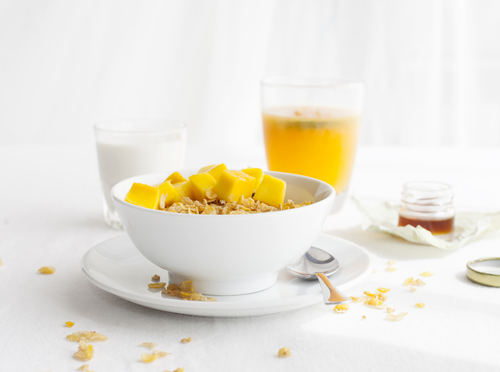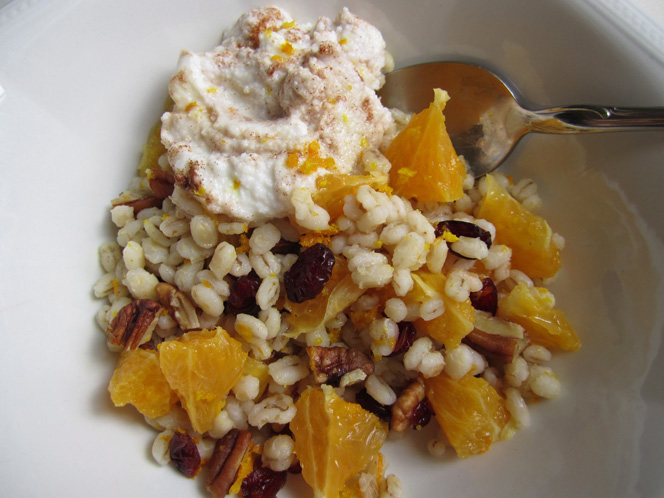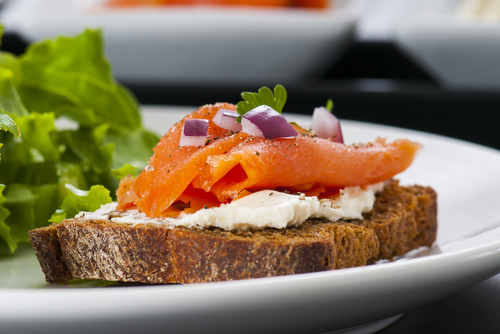When fall is in the air, pumpkins are pretty much everywhere, and that means canned pumpkin gets the front-of-aisle spotlight at grocery stores everywhere.
If you’re like many people, you probably only think to grab canned pumpkin for that pie you need to bring to Aunt Bettie’s on Turkey Day. But we’re here to tell you that it’s time to use this orange goodness for more than the typical fare. We’ll get to our 6 Genius Ways to Use Canned Pumpkin below. But first, let’s talk about…
Health Benefits of Pumpkin
Pumpkin is ridiculously healthful. It’s loaded with vitamin A (which is important for healthy skin and fighting a cold), flavonoids, carotenoids, and zeaxanthin (which helps keep your peepers strong). On top of that, it’s filled with fiber.
So go grab a few cans (try to make them organic and be sure not to get the kind that has added sugar!) and get ready to chow down on this healthy, versatile food.
RELATED: What’s the Difference Between Gourds, Squash, and Pumpkins?
6 Genius Ways to Use Canned Pumpkin:
- Add it…
- To yogurt
- To oatmeal
- To pancakes, waffles, crepes
- To toast with a drizzle of honey
- To legume dishes, such as lentils, chickpeas, or black beans
- To sour cream (for soups and tacos)
- To curry, soups, chili, or stew
- Breakfast it. Pumpkin blends into a smoothie like it was invented just for that purpose. It mixes into your favorite hot cereal without making it too heavy. It spreads on toast like a dream. You can even pumpkin-up your morning coffee by mixing a spoonful of pumpkin into your milk and heating it up before pouring it in (and here’s a great place to add a shake of pumpkin pie spices to boost the flavor).
- Fat-replace it. You already know you can use applesauce in lieu of butter or oil, but pumpkin also works! Try it in cornbread, chocolate cake, and bran muffins. You’ll get all of the benefits, plus the added flavor that your friends will go nuts for.
- Mask it. Holiday season getting to your skin? Take care of it with a pumpkin mask that is simple to make with ingredients you have in the kitchen. Pumpkin and Greek yogurt in equal proportions is just one simple idea, or try this amped-up version. Just make sure you bring a spoon; you might want to eat the leftovers. Oh, and put leftovers in a glass container to keep it fresh longer.
- Love it. Pumpkin is a known aphrodisiac. Mix your leftover pumpkin with some essential oils or sensual spices and heat it with a warming candle by your bedside to fragrance the room and amp up the passion.
RELATED: 7 Sex-Drive Foods to Boost Your Libido
- Freeze it. Sometimes, you just want to be done with the leftover canned pumpkin. We get it. But don’t toss it, freeze it! Pour it into an ice cube tray, then, after it freezes, save the cubes in a plastic bag in the freezer. You’ll never be pumpkin-less again, and you’ll actually have smaller portions ready to roll for your next pumpkin recipe.
Become a Nutrition Coach
Love learning about how something as simple as canned pumpkin can impact your health and wellness? Consider joining our amazing, thriving Become a Nutrition Coach community and learn everything you need to know to make wellness and nutrition your new job or side hustle.
Request a sneak peek of our Master Certified program today—we’ll see you inside!
3 Fast, Delicious & Healthy Lunch Ideas for You & Your KidsLunch ideas are one of the world’s most precious commodities. Ok, maybe that’s exaggerating. They’re only one of the world’s mom’s most precious commodities.
It’s hard enough to figure out what you want for lunch and how you are going to eat healthy, never mind keeping up with your kids likes, jags, dislikes and gripes.
The sight of their lunch boxes may make you cringe in the same way your email inbox does after a two week vacay. And your own brown bag? You’re lucky if it makes it out the door with you in the morning.
For kids, lunch should be all smiles, rainbows and unicorns, but for the mom behind the meal, it can be a black cloud with no clearing in sight.
I get it. I empathize. I make lunches all year, too, and it can get discouraging.
But I can help.
3 Fast, Delicious & Healthy Lunch Ideas for You & Your Kids
PB&J: old school processed pb and sugary jelly smushed between white bread is kinda a nutrition nightmare. However, it can be transformed into a nutrition powerhouse before you can say JIFfy. This one will be the whole fam’s jam.
- Upgrade your nut butter (think almond butter, boutique nut butters, like Nutzzo or simply any natural pb) and spread the “P” on whole grain bread, Ezekiel bread, or high fiber crackers.
- While you’re at it, swap your sugar-filled jelly with freshly sliced strawberries (or you can have one of your nuggets mash ‘em for you), an all fruit spread or even dehydrated fruit for a little crunch. This modern way pulls out a bunch of the sugar and takes the nutrition up a notch with vitamin C and fiber.
Fruit + Yogurt + Veggies: Who says you need meat to make a complete lunch box? This one, two, three and done lunch will take you less than minute (no joke) to prep. You’re welcome.
- A whole piece of fruit requires no assembly, packaging or cutting. Take your pick, apple, pear, banana (they’ll all give you antioxidants and fiber) and add it to a Chobani yogurt tube (your kids will thank you when they’re grown for not ignoring their protein and calcium consumption).
- Top the combo off with sweet mini peppers on the side (my kids pop these in their mouths like candy!). You can buy these antioxidant powerhouses in bulk and there is not one bit of cutting or slicing required.
Satisfy your (yes, we’re lookin’ at you mom!) Mexican Craving: Chips, guac and enchiladas on your mind? I’ll save you the calories and the trip to the taqueria.
- Chobani Greek Flip Sriracha Mango may just be your new partner to a margarita. This non-GMO yogurt has 12 grams of protein, no artificial sweeteners (woo hoo) and is exploding with flavor. But, you need something to replace that chip crunch, right? It’s got that too. It comes with Sriracha coated rice crisps and cashews – right there on the side!
- Make this a complete “meal” with protein, fiber, healthy fat and adequate calories by adding a handful of mixed nuts. Done and done.
**this post was in partnership with Chobani**
How to Eat Healthy Without Getting BoredSo you either already learned how to eat healthy, or you’re now learning to eat healthy, but you can’t possibly eat another carrot stick or suck down another green juice and don’t even get you started on scrambled egg whites for breakfast every.single.day. Sound familiar?
Ever wish you could just invent new foods? It’s something I hear about often from my clients. They are b-o-r-e-d with their healthy routine.
After a few weeks or months of following various diet plans, it’s easy to lean too heavily on the same few healthy foods and meals. (Your refrigerator just called, and it’s really tired of yogurt, too!)
So while I can’t conjure up a variety of broccoli that tastes like chocolate or transform salad greens into pasta or create a new fat burning food, I do know there are hundreds of tricks to put new zing in your old healthy eating standbys.
Learning how to eat healthy doesn’t have to be the most boring thing you’ve ever done, and staying healthy doesn’t have to be an exercise in monotony.
How to Eat Healthy Without Getting Bored
Shake up your yogurt routine
- Make it savory: Instead of adding fruit, cinnamon or honey to your yogurt, add ¼ cup of chopped cucumbers, ¼ cup of tomatoes, ½ teaspoon of olive oil, and a dash of red wine vinegar for a tangy, Mediterranean-inspired snack. Pair it with raw veggies.
- Make it dessert-worthy: Add 1 tbsp of natural peanut butter and 1 tsp cocoa powder for a peanut-buttery chocolate treat. Note: you can do this with oats too!
- Make it tea-licious: Green tea doesn’t just belong in a mug. Sprinkle in 1 tbsp of matcha powder and stir some antioxidants right into your bowl.
Add sex appeal to sandwiches
- Try something richer: Spread on a little healthy fat, from hummus, mashed avocado or a nut butter.
- Crunch it up: Sprinkle sliced almonds, finely chopped walnuts, or cashews on turkey or grilled chicken wraps.
- Make it ethnic: Mango chutney or spicy salsa can give your sandwich some flavor pizzazz.
Un-blah food with more flavor
- Turn up the heat: Cayenne pepper, red pepper flakes, wasabi or hot sauce make so many dishes more interesting, from your morning eggs to your evening chicken breast. Diet food does not mean tasteless food. Remember this always.
- Rediscover zest: Add fresh lemon or lime juice, white balsamic vinegar, pomegranate champagne vinegar or ginger rice vinegar to kick up the flavor profile of savory dishes, especially fish.
- Make it earthy: Add mixed mushrooms (shitake, Portobello, Oyster) to tomato sauce, stir fries or tacos for a woodsy, hearty flavor, or if you’re sick of lettuce wrapped turkey burgers try portobello mushrooms with the turkey burger in between.
Healthy Breakfasts That You Haven’t Thought Of
Think starting your day with a cup of coffee counts as breakfast? Think again.
You’ve heard it before: you should start everyday with a healthy breakfast. But if it’s fallen on deaf ears, let me try and say it a little louder for you: HEALTHY BREAKFASTS ARE A MUST!
Eating breakfast is important for revving your metabolism in the morning and curbing hunger later in the day.
If cereal and milk isn’t your thing (that’s actually a good thing!), it’s time to think outside the (cereal) box.
Healthy Breakfasts That You Haven’t Thought Of
 Oatmeal that isn’t as boring as, well, oatmeal. Take plain oatmeal from blah mode to vacation mode like Tropical Sunrise Oatmeal or to turbo mode like Supercharged Oatmeal. Both recipes are super easy and way tastier than just adding water like you did in college. You’ve come a long way since your dorm room hot pot, so celebrate over a proper bowl of porridge.
Oatmeal that isn’t as boring as, well, oatmeal. Take plain oatmeal from blah mode to vacation mode like Tropical Sunrise Oatmeal or to turbo mode like Supercharged Oatmeal. Both recipes are super easy and way tastier than just adding water like you did in college. You’ve come a long way since your dorm room hot pot, so celebrate over a proper bowl of porridge.
 Get your brain on grains. Shake up your morning with whole grains you normally reserve for dinner like brown rice, barley, and quinoa. These fiber and protein-rich wheat-free grains taste great simply heated up with milk, such as almond, cow’s, or coconut, or you can add ½ cup fresh berries, ½ tsp honey, 1/8 tsp cinnamon, and ¼ tsp vanilla for extra flavor.
Get your brain on grains. Shake up your morning with whole grains you normally reserve for dinner like brown rice, barley, and quinoa. These fiber and protein-rich wheat-free grains taste great simply heated up with milk, such as almond, cow’s, or coconut, or you can add ½ cup fresh berries, ½ tsp honey, 1/8 tsp cinnamon, and ¼ tsp vanilla for extra flavor.
 Go fish. Fish for breakfast? Yes! If you’ve never tried (or pronounced) taramasalata, now’s your chance to become a breakfast lover. Perhaps the reason you never got into breakfast was because you only stuck to croissants and bagels and never thought of seafood as an option. Here’s a great recipe for lox and toast, and here’s another yummy one for salmon pesto tartine.
Go fish. Fish for breakfast? Yes! If you’ve never tried (or pronounced) taramasalata, now’s your chance to become a breakfast lover. Perhaps the reason you never got into breakfast was because you only stuck to croissants and bagels and never thought of seafood as an option. Here’s a great recipe for lox and toast, and here’s another yummy one for salmon pesto tartine.
 Griddle me this. Give the whole flapjack thing another chance. Experiment with Spiced Applesauce Pancakes or shake things up by replacing flour with quick-cooking oats in this easy Oatmeal Pancake recipe. Top your hotcakes with ½ cup Greek yogurt or ¼ mashed mango instead of syrup if you aren’t into sticky fingers and that whiff of maple syrup that lingers through lunchtime.
Griddle me this. Give the whole flapjack thing another chance. Experiment with Spiced Applesauce Pancakes or shake things up by replacing flour with quick-cooking oats in this easy Oatmeal Pancake recipe. Top your hotcakes with ½ cup Greek yogurt or ¼ mashed mango instead of syrup if you aren’t into sticky fingers and that whiff of maple syrup that lingers through lunchtime.
Finally, don’t forget the psychological power that breakfast has when you make healthy choices in the a.m. You somehow just feel better about your whole day, and you’re more likely to make better choices at lunch and dinner when you start the day fueled on healthy foods.
Should You Take Probiotics?
Ask Keri: Should I be taking probiotics?
Keri Says: I get this question. A lot. I’ve realized that most people asking, however, don’t even know what probiotics are.
So, before I answer whether you should or shouldn’t be taking one, here is the 411 on what they are.
What are probiotics?
Probiotics are defined by the World Health Organization (WHO) as “live microorganisms, which, when consumed in adequate amounts, confer a health benefit on the host.” Because of these benefits, probiotics are often referred to as “good” or “friendly” bacteria. In case, you’re still confused, you are the host.
What is the intestinal microbiota, and how does it affect digestive health?
A complex ecosystem of bacteria, known as the “intestinal microbiota,” develops after birth and lives in the intestinal tract. Yes, we all have a whole ecosystem of bacteria in our guts. The intestinal microbiota contains both “good” and “bad” bacteria. When the balance is tipped toward “bad” bacteria, which can be due to lack of sleep, stress, or various other causes, it may affect digestive health and overall well-being. Consuming certain probiotics can help this whole gut situation by providing a regular source of “friendly” bacteria to the intestinal tract, improving how it functions.
Are all probiotics the same?
No. There are many strains of beneficial cultures that have probiotic potential. But the benefits associated with probiotics are strain-specific (and these benefits must be established through adequate studies.) Also, the range of benefits can vary according to the amount consumed.
Live cultures are microbes used to ferment foods. Not all live and active cultures are probiotics (meaning they don’t all have studies supporting specific benefits.) Therefore a product that contains live and active cultures does not necessarily qualify as a probiotic.
What are some of the benefits of probiotics?
The benefits that are known today include helping to regulate the digestive system, helping to support the immune system, and helping to maintain your overall health. There is a lot of research going on in the area of probiotics connected to weight and brain health, too.
What does the “Live Active Cultures” seal mean?
The “Live Active Cultures” seal was established by the National Yogurt Association to help consumers distinguish between yogurts that contain a minimum level of live and active cultures and those that do not. It’s important to note that not all live and active cultures are probiotics.
In addition to consuming probiotics, what can the average person do to maintain good digestive health?
The World Gastroenterology Organization (WGO) recommends the following tips for maintaining good digestive health:
- Incorporate fermented dairy products into your diet (I say aim for one a day!)
- Include foods rich in fiber
- Drink plenty of fluids
- Reduce intake of fried, fattening foods
- Eat small, frequent meals
- Don’t rush eating
- Exercise regularly and abstain from smoking
- Maintain a healthy body weight
- Consume fish 3-5 times per week
- Select lean meats
So, should I take a probiotic supplement?
I recommend that most people include a serving of fermented food each day (kimchi, kefir, sauerkraut) and take a probiotic as insurance for good gut health (in addition to doing your best to adhere to the above tips.) If you have specific concerns (immunity, constipation, diarrhea etc.), make sure to take a probiotic with a specific strain that has been proven to aid that condition.